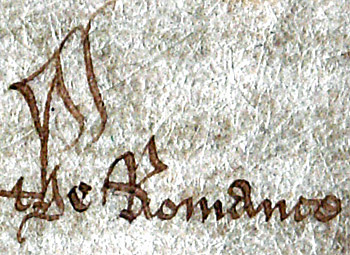Guy of Warwick (All Versions)
General Information
Plot Summary

Note: the different versions of Guy of Warwick are often treated as separate texts but have been grouped together here for ease of reference. This entry includes: the ‘Couplet’ version, probably composed in c.1300 and the basis for many later redactions (IMEV 3145); the early 15th-century or ‘Later Couplet’ version (IMEV 3146); and the continuations known as the ‘Stanzaic Guy’ (IMEV 946) and ‘Reinbroun’ (IMEV 1754), both written in 12-line tail rhyme stanzas and unique to the Auchinleck Manuscript. The summary is based on the ‘Later Couplet’ version which provides the fullest English rendering of the story.
Guy, the son of a steward, falls in love with Felice, daughter of the Earl of Warwick, who rejects him because he is not a knight. The Earl knights Guy, but Felice still demands that he prove himself. He leaves England with his mentor, Herhaud, unhorsing Duke Otous of Pavia during a tournament in Normandy, then winning glory throughout Europe. After a year they return to Warwick, where Felice accepts Guy’s love but refuses to marry him until he is the greatest knight in the world. He departs for Europe again, and accomplishes more feats before being ambushed by Duke Otous. All his companions are slain except Herhaud, whose mortal wounds are healed by monks.
Reunited, Guy and Herhaud go to the aid of Duke Segyn, who is being besieged by the Emperor of Germany and Duke Otous. Sir Tirri of Gormoise rallies the Germans, but they are eventually put to flight. When the Emperor mounts another siege, Guy intervenes and negotiates a reconciliation. He and Herhaud then travel to Constantinople, where they help the Eastern Emperor defeat a Saracen army. Remembering Felice, Guy declines to marry the Emperor’s daughter, and when a jealous steward kills a lion that he has rescued, he and Herhaud leave the court.
On their way through Europe they encounter a badly wounded Tirri, who has argued with Duke Otous over his lover, Oisel. Guy rescues the couple and the two knights become sworn brothers. Together they defend Tirri’s father against Otous and Oisel’s father, Duke Loyere. Otous uses a trick to capture Tirri and Herhaud but Guy follows them to Pavia, where he becomes a jailor, frees Tirri and slays the Duke as he tries to marry Oisel. They all return to Gormoise and make peace with Loyere, who marries Oisel to Tirri. After a hunting trip results in a skirmish with an Earl, however, Guy resolves to return to England after his seven year absence.
Guy is welcomed by King Athelstan and slays a dragon before presenting himself to Felice. They are married and conceive a child, but after fifty days Guy realises his sins and his debt to God. He resolves to spend his life in penance and, ignoring Felice’s pleas, departs on a pilgrimage. After visiting Jerusalem, Guy agrees to act as champion for a Saracen king, Triamour, who promises to free his Christian prisoners in return. Keeping his identity secret, Guy defeats the hideous and unchivalrous giant Amorant, then continues his journey. Meanwhile, Guy’s son, Reinbrun, is stolen from Felice by merchants and presented to King Argus of Africa. Herhaud searches for him without success and is imprisoned by the African Emir Persan.
While in Germany Guy meets Tirri, who has been blamed for Otous’ death by the Duke’s heir, Barard, steward to the Emperor. Concealing his identity, Guy offers to fight Barard on Tirri’s behalf. After a day of combat the steward’s men throw Guy’s bed into the sea, but he survives and resumes the fight, slaying his opponent. Tirri is reconciled with the Emperor and he and Guy return to Gormoise, where Guy finally reveals his identity to his old friend.
Still dressed as a pilgrim, Guy finally returns to England which is being attacked by the Danes and their champion, a ferocious African giant called Colbrond. Advised by an angel, Athelstan begs the unknown pilgrim to accept Colbrond’s challenge, and Guy reluctantly agrees. The fight is fierce, but when Guy’s sword breaks he beheads the giant with one of his own axes. The Danes depart and Guy travels to Warwick, still in his pilgrim’s clothes. After a brief anonymous visit to Felice’s castle he retires to a hermit’s cell, where Archangel Michael tells him to prepare for death. He sends his ring to Felice, who arrives just as her husband’s soul ascends to heaven. When Guy’s body becomes miraculously heavy, he is buried in the hermitage, where Felice dies at his graveside. Eventually Athelstan allows Tirri to take the bodies to Lorraine, where he founds an abbey in their honour.
Meanwhile, Emir Parsan learns that Herhaud is a famous knight and releases him from prison. He helps the Emir regain his lands from King Argus and fights his champion, a valiant young knight who eventually reveals that he is Guy’s son, Reinbrun. Joyfully reconciled, he and Herhaud leave Africa for England. On their way, they learn that Amis of Monteyne, an old ally of Guy, has been imprisoned by a fairy knight. Reinbroun rescues him from a magical palace and defeats the fairy. He and Herhaud then travel to Burgandy, where they encounter another mysterious young knight. He fights Reinbrun before identifying himself as Herhaud’s son, who left England to seek his father. They all return to England together, and are welcomed by the king.
From: J. Zupitza, ed. The Romance of Guy of Warwick: The Second or 15th-century Version. Oxford: Oxford University Press, 1966. EETS e.s. 25 and 26. (Cambridge, University Library MS Ff. 2.38)
Manuscripts
Click a title below to search for all romances in that manuscript.